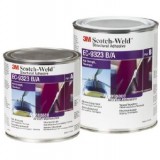
Instructions for use
While this information is provided as general application guideline based upon typical conditions, it is recognized that no
two applications are identical due to, among other things, differing assemblies, methods of heat and pressure application,
production equipment and other limitations. It is therefore suggested that experiments be run, within the actual constrains
imposed to determine optimum conditions for your specific application and to determine suitability of product for
particular intended use.
Process step Instruction
Surface preparation The strength and durability of a bonded joint are dependent on proper treatment of the surface to be bonded. An
acclimated, thoroughly cleaned, dry, grease-free surface is essential for maximum performance. Cleaning methods
which will produce a break free water film on metal surfaces are generally satisfactory.
At the very least, joint surfaces should be cleaned with a good proprietary degreasing agent and mechanically
abraded, e.g. with 3M Scotch-Brite™ 7447. Abrading should be followed by a second degreasing treatment, e.g. with
3M 08984 Adhesive Cleaner.
Optimum processing temperature for substrates and adhesive is around room temperature of 23 °C.
Application This product consists of two parts. Combine Part B and Part A in a separate container just prior to application in the
proportions specified. Note: Mix ratio deviations above +/- 5 % have significant influence on material performance.
Mix both components thoroughly until a uniform colour is obtained. Important: Be careful when mixing quantities
larger than 100 grams, because exothermic reaction may occur. Apply adhesive to parts to be bonded before the
work life expires, e.g. by spatula. Note: Work life depends to some extent on mixed quantity and the shape of the
container. Use of a shallow container will minimize the quantity impact. In order to obtain optimum mechanical
performance, the joint components should be assembled and clamped as soon as the adhesive has been applied and
before end of the open time. A fixation of the joint and an even contact pressure throughout the joint area during cure
will ensure optimum performance. Maximum shear strength is obtained with 0.10 – 0.20 mm bond line thickness.
Close the containers after use to protect the material against humidity.
Curing Once mixed, Scotch-Weld™ EC-9323 B/A will gel in 3 hours, build up handling strength in 4-5 hours and fully cure
within 14 days at room temperature. Note: Lower temperature will slow down the reaction times. Curing time can be
accelerated by mild heat. Following times and temperatures will result in a full cure:
14 days at 23 ± 2 °C
2 hours at 65 ± 2 °C
15 minutes at 100 ± 2 °C
Note: The curing temperature may have influence on the final product performance.
Cleaning Excess uncured adhesive can be cleaned with ketone type solvents. After cure the adhesive can be removed
mechanically. Note: When using solvents, extinguish all ignition sources, including pilot lights, and follow the
manufacturer’s precautions and instructions for use.
Storage and Handling Store the product at room temperature. Shelf life is 12 months from date of shipment in the original unopened
containers.
Important notice: All statements, technical information and recommendations in this data sheet are based on tests 3M believes to be reliable, but the accuracy or
completeness of those tests is not guaranteed. All technical data and information should be considered typical or representative only and should not be used for
specification purposes. Given the variety of factors that affect the use and performance of a 3M product, some of which are uniquely within the user’s knowledge and
control, it is essential that the user evaluate the 3M product before use to determine the suitability of the 3M product for the intended use and method of application. All
questions of liability relating to the 3M product are governed by the terms of the sale subject to, where applicable, the prevailing law.